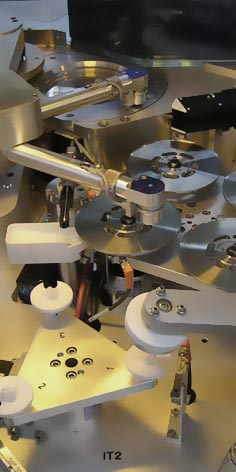DVD Replication
Pressing of the Most Popular Types of DVD Discs (outer diameter of 120 mm and 80mm / 3 inch).
Metal coating
- DVD 5 and 8 cm / 3 inch DVD (mini) 1,34 GB: only one layer is metallized, using aluminium
- DVD 9 and 8 cm / 3 inch DVD (mini) 2,41 GB: inner layer – metallized, using aluminium outer layer – metallized, using silicon (semi-transparent)
- DVD 10 and 8 cm / 3 inch DVD (mini) 2,68 GB: both layers metallized, using alluminium
Quality
Quality of each DVD is checked in the production process using a multistage checking procedure:
- Checking the extent of metallizing
- Checking the “bonding” (whether the adhesive is spread evenly)
- Checking the mouldings (both Layer 0 and Layer 1)
Furthermore, all analogue and digital parameters of the DVD are measured and checked.
DVD types
All DVD types listed comprise two substrates that have to be bonded together:
| DVD TYPE | CAPACITY | RECORDING LAYER | READING | DISK TYPE |
| DVD 5 | 4,7 GB | outer layer | from one side | single-sided, single-layer |
| DVD 9 | 8,5 GB | both layer | from one side | single-sided, dual-layer |
| DVD 10 | 9,4 GB | both layer | from both sides | single-sided, single-layer |
8 cm (3 inch) mini DVD types
| DVD TYPE | CAPACITY | RECORDING LAYER | READING | DISKU TYPE |
| 8cm DVD5 | 1,34 GB | outer layer | from one side | single-sided, single-layer |
| 8cm DVD9 | 2,41 GB | both layer | from one side | single-sided, dual-layer |
| 8cm DVD10 | 2,68 GB (1,34 GB + 1,34 GB) |
both layer | from both sides | single-sided, single-layer |
DVD Formats
At first glance, DVD disc looks the same as CD. It has the same diameter and thickness and uses the same non-contact method of reading data by laser beam. DVD recording capacity is several times higher than the CD’s 0.65 GB.
There are several DVD formats:
DVD – Video
MPEG-2 video, up to 8 audio language versions and up to 32 subtitle versions plus 9 various camera angles available. DVD -Video disc also features a navigation system for easy access to the particular information stored on the disc and to other functions.
DVD – ROM
uses the popular UDF/ISO (Universal Data Format /Industrial Standard Organisation) format readable under all PC operating systems that support UDF.
DVD – Audio
In addition to the large capacity provided by the DVD format, DVD – Audio’s benefits include the possibility of storing a digital sound recording with a higher sampling frequency (48 kHz, 96 kHz or 192 kHz) and a greater data resolution (up to 24 bits for DVD – Audio instead of Audio CD’s 16 bits).
Hybrid DVD
Hybrid DVD
is a combination of two or more formats.
The main benefits of the DVD technology are
- Superior image available in broadcast quality plus surround sound
- Large capacity of the disc, allowing to store more than two hours of video on a DVD 5 disc
- Interactivity, providing perfect (fast and easy) navigation within DVD title’s structure, i.e. accurate access to any specific sequence of this huge volume of information stored on the disc or to a specified section of the video programme within one-second accuracy, as well as the availability of the repeat mode and the forward/reverse and fast/slow step motion
- Disc’s capability of holding up to 8 language versions, which can be arbitrarily switched between while viewing the title
- Making use of up to more 32 text layers for subtitles in various languages, which the user can also change arbitrarily
- A choice of up to 9 viewing angles accessible while watching the title
- Up to 8-level security preventing access to selected information
- Support for widescreen picture and the 16:9 aspect ratio (e.g. one side of a double-sided DVD 10 disc may contain the 4:3 presentation while the 16:9 presentation may be stored on the other side)
- Discs indestructible by being played, resistant to magnetic field and easy to store
- DVD format’s versatility plus features encouraging its use for a wide range of human activities

